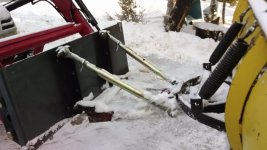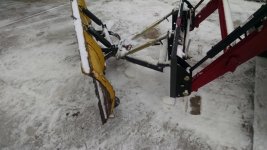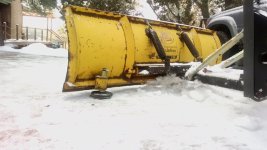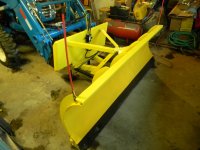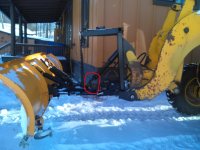alia176
Silver Member
Converted a Meyer snowplow into a SSQA for my Mahindra
Happy NY to all!
I purchased a Meyer 6.5" plow and fabricated a simple mount for the SSQA. I kept the same system as a typical pickup truck so that I can sell this plow if for some reason I need to.
This is the first time I've ever used a snow plow so I'm still figuring some things out. However, the scraper blade (moldbord?) is fairly worn down so I think I'm going to be ordering a new one shortly. Attached are the pics and you'll see a noticeable gap. Even if I remove all the washers and push the skid pucks all the way up, there is still a large enough of a gap. Since I don't have chains, this is probably a good thing, otherwise, the tractor gets pushed around as it is! I'm plowing a dirt/gravel road and a small part of it is a rather steep hill. I tried plowing w/o the pucks and end up digging down into the dirt too much. A friend suggested picking a rubber blade or see if the local DOT might have one that I can cut up and use for my application.
When I turn the plow to one side or the other, there is a noticeable tilt that occurs. Meaning, one corner touched the ground before the other side. Is this a normal thing? I don't think this is a bad thing, just an observation.
Currently, I'm plowing with the front and then clean up with the rear blade. Truthfully, the rear drag blade seems to be a better job doesn't tend to bog the tractor down as much. Tire chains are definitely on my horizon and I"m looking for a set of 18wheeler on CL. This guy is swinging through Albuquerque in a couple of weeks and I'll pick up his old set for $40.
Let me hear your thoughts please.
Happy NY to all!
I purchased a Meyer 6.5" plow and fabricated a simple mount for the SSQA. I kept the same system as a typical pickup truck so that I can sell this plow if for some reason I need to.
This is the first time I've ever used a snow plow so I'm still figuring some things out. However, the scraper blade (moldbord?) is fairly worn down so I think I'm going to be ordering a new one shortly. Attached are the pics and you'll see a noticeable gap. Even if I remove all the washers and push the skid pucks all the way up, there is still a large enough of a gap. Since I don't have chains, this is probably a good thing, otherwise, the tractor gets pushed around as it is! I'm plowing a dirt/gravel road and a small part of it is a rather steep hill. I tried plowing w/o the pucks and end up digging down into the dirt too much. A friend suggested picking a rubber blade or see if the local DOT might have one that I can cut up and use for my application.
When I turn the plow to one side or the other, there is a noticeable tilt that occurs. Meaning, one corner touched the ground before the other side. Is this a normal thing? I don't think this is a bad thing, just an observation.
Currently, I'm plowing with the front and then clean up with the rear blade. Truthfully, the rear drag blade seems to be a better job doesn't tend to bog the tractor down as much. Tire chains are definitely on my horizon and I"m looking for a set of 18wheeler on CL. This guy is swinging through Albuquerque in a couple of weeks and I'll pick up his old set for $40.
Let me hear your thoughts please.
Attachments
Last edited:
